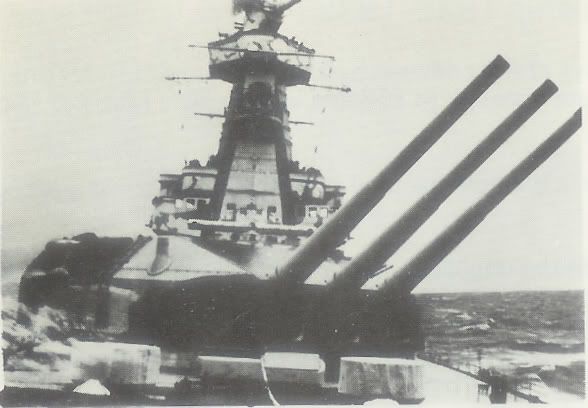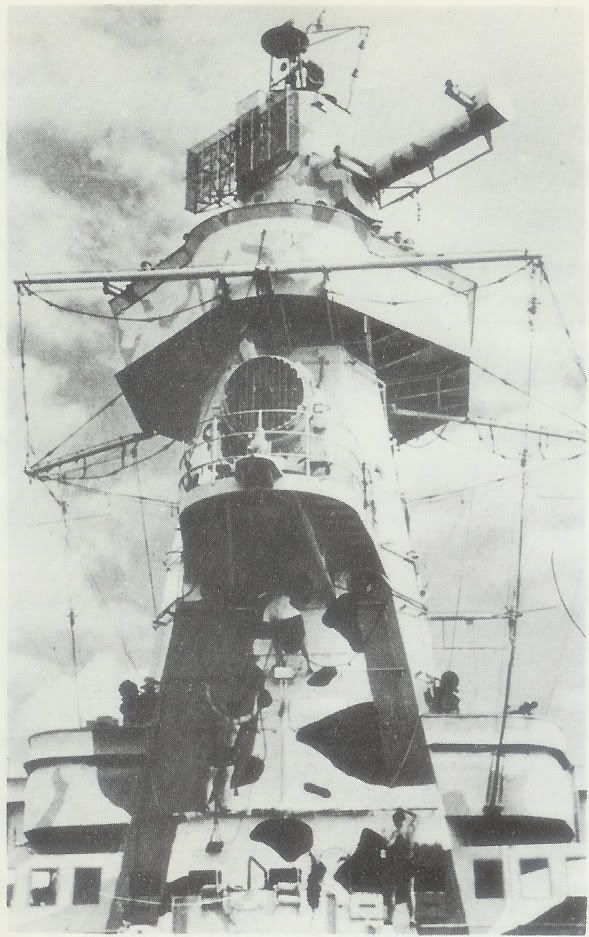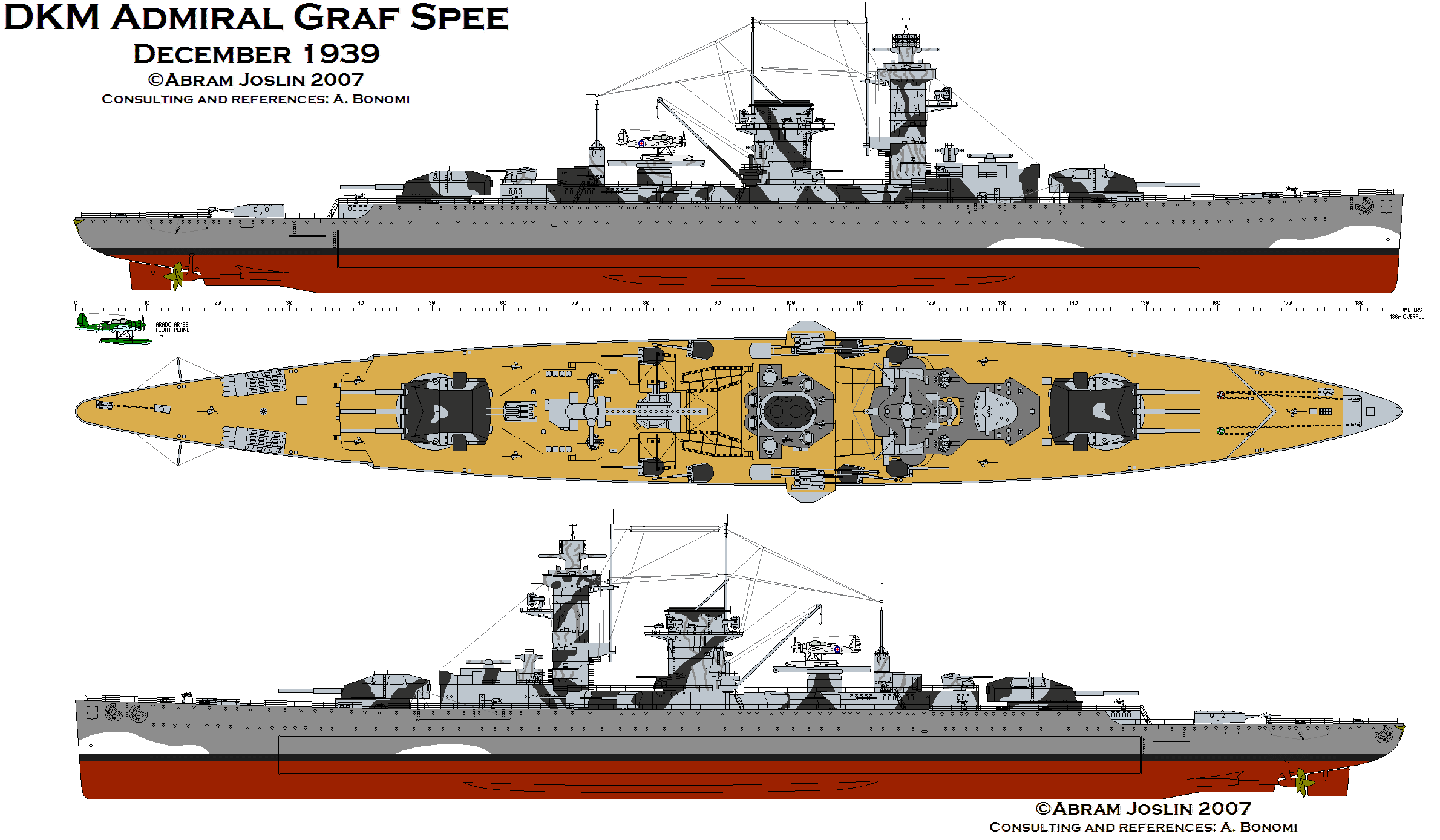Do any of you know the colors/colorscheme for this ship? My great nephew says that no colors are given in his kit, and we will be working on it tommorrow.
Thanks, doc
Do any of you know the colors/colorscheme for this ship? My great nephew says that no colors are given in his kit, and we will be working on it tommorrow.
Thanks, doc
Photos are availalbe at http://www.deutschland-class.dk/admiral_graf_spee/gallery/gallgrafspeemontevideo.html which show the camo patterns. I have an old set of intructions from a Fujimi 1/700th kit. Send me a message with your e-mail address and I’ll scan a jpeg for you. - the colors are by name (olive drab + gray, tan, mahogany, flat black,silver, “gray tinged brown”, white), not any standard or paint chip callout.
Google Graf Spee and you may be able to find more on specific colors.
I certainly don’t claim to be an expert on German (or any other) WWII warship colors, but I did some digging into the story of this particular ship some years ago when I was working on a model of her. (The kit I used, incidentally, was the Italeri 1/720 one, which is currently being sold by Revell Germany. It’s one of the nicest small-scale warship kits I’ve encountered. Highly recommended.)
Two big caveats at the beginning. One - I’m not into FS numbers and official color names. I suspect the White Ensign “Colorcoats” range has all the colors I’m about to mention, but Microsoft has done something crazy to my computer recently: the White Ensign site is one of several that, when I try to go to them, cause my browser to shut down. (Another one is the site for the U.S.S. North Carolina. I’ve complained to Microsoft.) Those with cooperative computers probably can get the official color names from White Ensign.
Second caveat - I built my model several years ago, and some additional material has appeared since then. Work on salvage of the the ship has started, and at least one book, http://search.barnesandnoble.com/German-Pocket-Battleships/Roger-Chesneau/e/9781861762092/?itm=9 , has been published. The author, Roger Chesneau, is an outstanding expert and undoubtedly knows more about the subject than I do. If anything in that book contradicts what I’m about to type, for heaven’s sake believe the book.
Anyway, I’m pretty certain that the Graf Spee only had one basic color scheme during her short career, but some interesting variations were introduced on a couple of occasions.
When she was commissioned she was (I think) painted in what was (I think) the standard scheme for major German warships of the 1930s: two shades of grey. The hull was sort of a medium grey with (I think) a slight bluish tinge. (I think it was called “outboard grey”; the White Ensign site probably can confirm or contradict that.) The other vertical surfaces (superstructure, turrets, etc.) were a noticeably lighter shade (“topside grey”). Horizontal surfaces, apart from the decks themselves, also were that lighter grey. The main deck was unpainted wood. The other decks appear to have been painted a very dark grey. (On my model I used the aircraft camouflage color “schwarzgrau”; to my eye it looks right in comparison with photos.)
In her early years the Graf Spee was a beautifully maintained, spit-and-polish ship, loaded down with all sorts of heraldry. The von Spee family coat of arms was installed, in the form of painted sheet metal shields, on each side of the bow. When the Nazi Party took over from the Weimar Republic, a cast bronze eagle was installed on her stern. (It’s recently been brought up from the wreck; there are some photos of it on the site to which schoonerbum kindly linked us.) The name “CORONEL” (the battle of Coronel, in 1914, was Admiral von Spee’s great victory) appeared on a metal nameplate munted on the forward side of the “fighting mast” (the forward superstructure). (I wish one of the aftermarket manufacturers would make that nameplate in photo-etched metal. But none of the sets I’ve found - on any scale - includes it.)
There were some other details that I couldn’t quite nail down. In several prewar photos it looks like individual coats of arms were painted on the sides of the two main battery turrets - but I haven’t found any pictures that really show what they looked like. And it appears that a black line, about 6" wide, was painted around the base of each major part of the superstructure - including the turret barbettes.
When the ship was on neutrality patrol during the Spanish Civil War, broad, athwartships stripes of red, white, and black were painted on the tops and sides of both main battery turrets. (A few months back I had the pleasure of reviewing a book called The Battlecruiser H.M.S. Hood: An Illustrated Biography, 1916-1941, by Bruce Taylor. One of my favorite pictures in it shows a pair of teams from the Hood and the Graf Spee getting ready to square off in a football match at Tangier in 1938.)
I think the Graf Spee kept that two-tone grey scheme until the outbreak of the war. She was in fact at sea, on what turned out to be her last voyage, when the war started. Sometime either shortly before or shortly after the declaration of war she acquired a camouflage scheme, consisting of a white “false bow wave” on the hull and some irregular stripes of at least one darker color on the superstructure and turrets. (I gather the new paint was applied by the ship’s crew - who also built a false second funnel to confuse observers.) Photos suggest pretty firmly that two colors, one noticeably darker than the other, were used for those stripes. I think the new colors were applied over the original two greys. (The excellent photos to which schoonerbumm linked us seem to suggest that, and it certainly seems logical - though I’d certainly be willing to be corrected on that point.) The eagle stayed on the stern, and “CORONEL” stayed on the fighting mast, but got obscured by one of the dark stripes. (You can barely make it out in a couple of the photos.) The shields on the bow were painted out. (The outlines of them are visible in several of the pictures.)
To my knowledge no color photos of the ship in that camouflage scheme exist. (That’s not surprising; she only wore it for a few months - most of which she spent out of sight of land.) Different sources seem to have different ideas as to the color of the stripes. As I understand it, a graphic that showed them as olive green was published by a British researcher shortly after the war. (I don’t remember the author or the title; sorry.) That rendering has influenced quite a few others over the years, but I have the impression that the green colors were pure guesswork on the part of the artist. Logically, to my mind, at least, darker greys or blues seem more likely - but clearly there’s some room for personal interpretation and taste there.
At any rate, the modeler has some choices. I did my model in the 1938 scheme - with the turret stripes, the coats of arms on the bow, and the eagle on the stern. (I made the eagle with Milliput - great stuff. I tried to put together the word “CORONEL” on the fighting mast from the little bits of text on the Gold Medal Models “German Warships” photo-etched set, but it defeated me. Come on, aftermarket companies - you could do it.) To me, she’s an extremely handsome ship in that scheme, and a symbol of an era in naval history. I’ve often thought it ironic that the twentieth century’s two most tyrannical nations, Nazi Germany and the Soviet Union, managed to build some of the best-looking warships ever. (Perhaps the *Graf Spee’*s case is mitigated a little bit by the fact that she was built before the Nazis came to power.)
Some relatively small but noticeable other points about her appearance changed as the color scheme evolved. Shortly before the war started (after the turret stripes were removed) a new-fangled radar set - one of the first mounted to a warship - was installed on the forward gun director. The ship’s one aircraft, a Heinkel biplane, was replaced by an Arado monoplane. (The Italeri instructions included advice on converting one to the other - not very convincingly.) As built, the ship was equipped with an apparatus on the port side called, informally, a “sail.” This consisted of a big piece of canvas fastened, sort of like an oversized window blind, to a boom that swung out from the shelter deck over the ship’s side. The idea was that that boom would be swung out and the “sail” stretched out to create a smooth area for the aircraft to taxi onto, prior to being picked up by the crane. (U.S. battleships and cruisers used something generally similar.) For one reason or another it didn’t work well, and shortly after the war started the crew got fed up with it and heaved it overboard. Kit manufacturers haven’t done well with that piece of equipment (in the Italeri kit it’s a vaguely-shaped, undersized blob - probably the weakest feature of the kit), but I believe at least one aftermarket set - the 1/700 one from White Ensign - includes it.
Hope that helps a little. She was a beautiful ship and makes a fine model. Good luck.
John,
Outstanding historical synopsis of this fascinating ship! I agree that the Italeri kit is the standout kit of the Graf Spee. Italeri also manufactured an exceptional Lutzow and early Admiral Scheer as well. Excellent writeup as usual!
Bill Morrison
This might not be a Microsoft thing. I had probems in the past with the WEM site that were caused by the little butons on the main page. They use Java, which is a fairly ubiquitous web/internet programming language by Sun Microsystems. Try going to your control panel → Add/remove and uninstalling all of the javas you see in the list (side note: java update is usually pretty messy and it’s not abnormall to see 3-4 older versions still hanging out). Then download the newest version, install it, and give it a try.
You can also get a listing of the WEM naval colors at ShipCamouflage.Com, either in their paint chips section or their WEM Paints page.
Well, my computer’s problems with the WEM site are solved. Mr. White nailed the problem: it had something to do with Java. Downloading the latest version was the solution - and downloading the latest automatically (I guess) removed the earlier versions. The U.S.S. NC site is also accessible again. Many thanks to Mr. White.
The White Ensign catalog does indeed offer a bunch of Kriegsmarine paint colors - but provides no indication of what goes where. I imagine the other sites Mr. White mentioned will be of help.
Just wanted to add a couple bits; when Graf Spee was on her celebrated cruise, she changed her camoflage a couple times. Intitially, a slghtly darker wavy pattern was painted over her hellgrau 50 upper works (the hull was kept in dunkelgrau 51, with the addition of a false bow wave). During October 1939, dark stripes were painted on the edges of the control tower, while the rest of the tower was kept light. This was to simulate a tripod mast from a distance, and apparently was very successful in doing so, as Graf Spee sank or captured a number of merchant ships in this guise. Later in November, a dummy funnel was added, as well as an additional dummy maingun turret forward. This ploy was removed and painted out shortly before her climactic battle at the Platte, with what appears to be a very dark stripe pattern over hellgrau 50 of much broader configuration than her earlier upper works ‘wavy’ camoflage. I haven’t seen any color photos of Graf Spee in any camo pattern, but certainly the old ‘Profile Warship #4’ gives some excellent views of the different patterns in BW.
I’d like to see more info on that, floatplanes being a favorite of mine. The USN used a “recovery sled” pretty consistently, the idea being that the floatplane could be retreived while underway. A combo of cargo net over canvas, dragged at the end of a cable, the Seagull etc. had a hook on the bottom of the center float, which is pretty clear in pics. Often a red flag on each corner so the pilot could see what he was taxiing towards. May have to model that Heinkel.
Hi Doc,
Others have referred to our website and our Colourcoats enamels. I’ll give you specifics for Graf Spee, with references to Colourcoats in parentheses. When she sortied her paint scheme was as follows:
Hull–Dunkelgrau 51 (KM 02); superstructure–Hellgrau 50 (KM 01); steel decks–Dunkelgrau 2 (KM 06); wood decks–Teak (C 01); boot-topping–Schiffsbodenfarbe III Grau 1 (KM 05); underwater hull–Schiffsbodenfarbe III Rot 5 (KM 04).
At the time of the Battle of the River Plate, they had painted false bow waves in white (C 03), plus a camouflage pattern over the Hellgrau 50 on the superstructure and turrets. The pattern used two darker grays–Dunkelgrau 2 and Dunkelgrau 51–over the light gray.
Photos and films taken of her in Montevideo harbor after the battle clearly show the camouflage pattern and the fact that 2 darker grays were used.
Cheers,
John Snyder, White Ensign Models, http://WhiteEnsignModels.com
More news, including boxart of Academy’s forthcoming 1/350 Graf Spee kit can be found here -
http://www.modelshipwrights.com/modules.php?op=modload&name=News&file=article&sid=5502
Did some hunting around for Graf Spee photos and drawings, and here are the results! Note, there seems to be some disagreement as to whether the camoflage was in some species of gray, or green (feldgrau), but think on it, it seems to me much more likely to be variations of gray, since this wopuld be the most likely color paints to be on hand for a warship at sea, but I will present both. First, here are a few photos from my files:
This shows the tower with its fake tripod paintscheme

This shows the tripod scheme being overpainted with her final paint scheme. Note how dark these splotches are in comparison with the quite light squiggles on the upper control platform

Next is a broadside view from Montevideo after the battle, where you can see the contrast between the older squiggle pattern and the darker splotch pattern

This drawing shows what the final camo colors might have looked like:

And if you want to view the whole set of drawings showing all the different variations for the Graf Spee over time, go to:
And this is the (apparently!) old interpretation of Graf Spee’s final camoflage (Feldgrau):

And here is a good view of the fake bow-wave, which in reality is not nearly as ‘neat’ a job as is generally portrayed in drawings and models:

And finally, a really good photo of the tower, which really shows the difference between the earlier lighter squiggle camo pattern, and the final much darker pattern applied just before her final battle:

Here’s the other side:

The theory, for capitol ships, was that you could put the wind on the opposite bow, to help make a lee, then you could stream lube or fuel oil to help lower the sea state to one where you could actually hook the aircraft to the recovery crane. That turns out to be the limiting factor, the hook would carry through the thin a/c skin when the sea tossed the a/c around on recovery. Which was an issue discovered with Pringle and the other Fletchers rigged for Kingfishers (not very much hull mass to make a lee, either).
But, this is all taking away from an excellent discussion on Graf Spee.
jtilley White Ensign Models makes a 1/700 scale set for the Graf Spee and the other Pocket Battleships of the same class.
and yes it includes the Coronel name plate and the brass eagle for the stern.
just look under ships then Photoetch and then 1/700 and you’ll find it.
When is Trumpeters 1/350 coming out? I thought it was supposed to be sometime this year.
Mikeym_us - By golly you’re right. I built my little Italeri Graf Spee quite a few years ago; I don’t think that sheet was available at that time. I used the one from Gold Medal Models, which is an outstanding piece of work in its own right - but doesn’t include the “CORONEL” plate.
I see the White Ensign sheet also includes the coats of arms for the bows of all three ships in the class. Photo-etched brass would be an ideal medium for them. (I’m not quite so confident about the stern eagle, which in reality is a deep, three-dimensional casting.)
I guess I ought to think about ordering this sheet and using it to improve my model. But I have to say that, in the current economy, paying that amount of money for that little plate with the word “CORONEL” on it…well, I’ll think about it…
John,
I just ordered three sets of the WEM photoetch for the panzerschiffe, one set for each of the ships. If you send your address, I will be happy to provide you with the “CORONEL” plate and the Graf Spee coat of arms.
Bill Morrison
Bill, that’s mighty generous of you! A PM is on the way.
I was planning on using it for the old 1977 Matchbox Graf Spee sure it might be a far stretch but alot of the parts on the Matchbox kit match up to the WEM instructions. Oh and Jtilly the set also has parts for the DeutchLand as well.